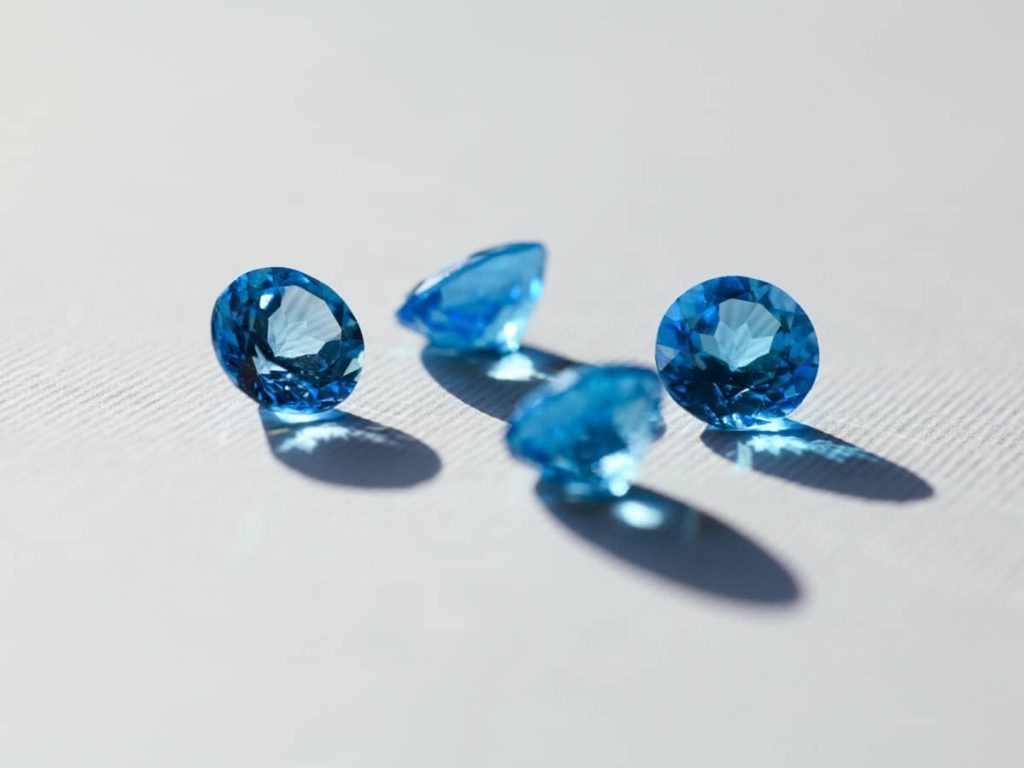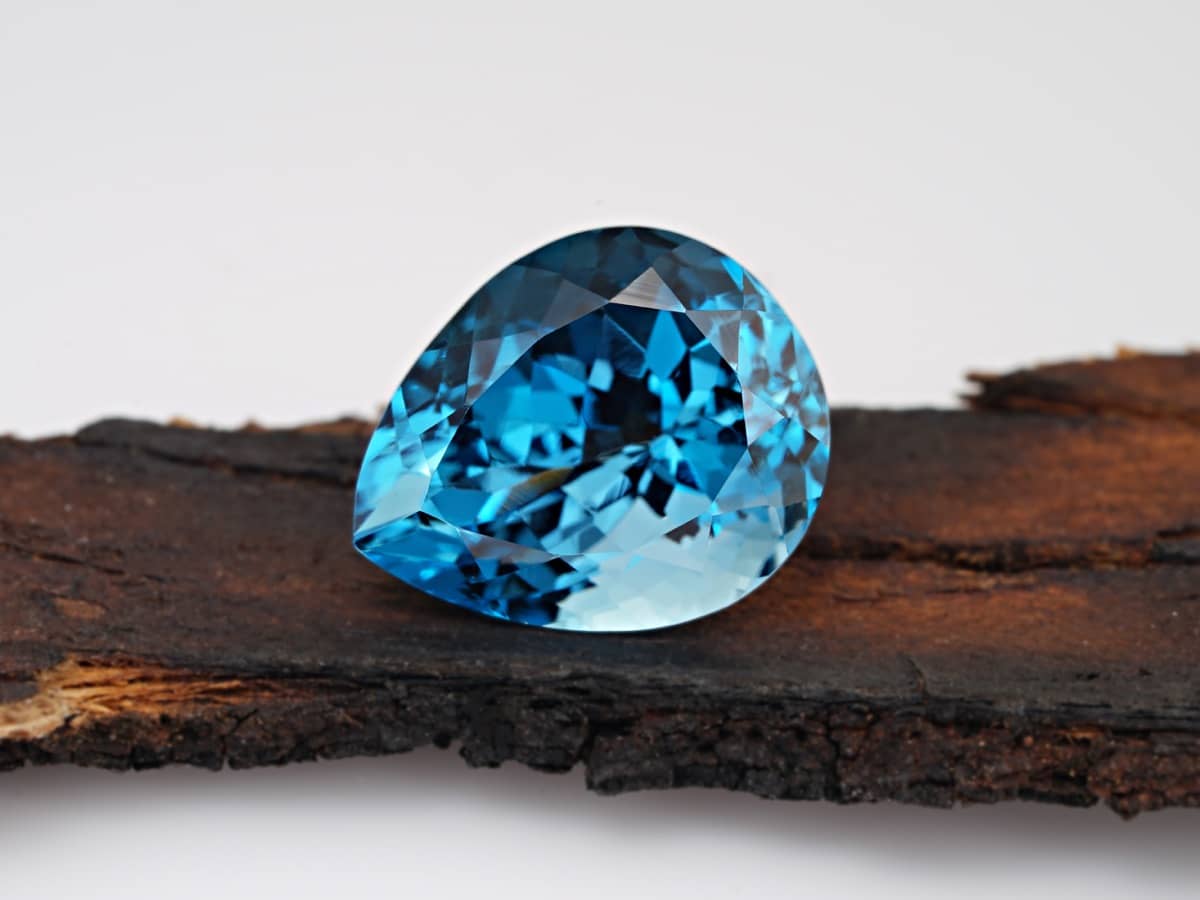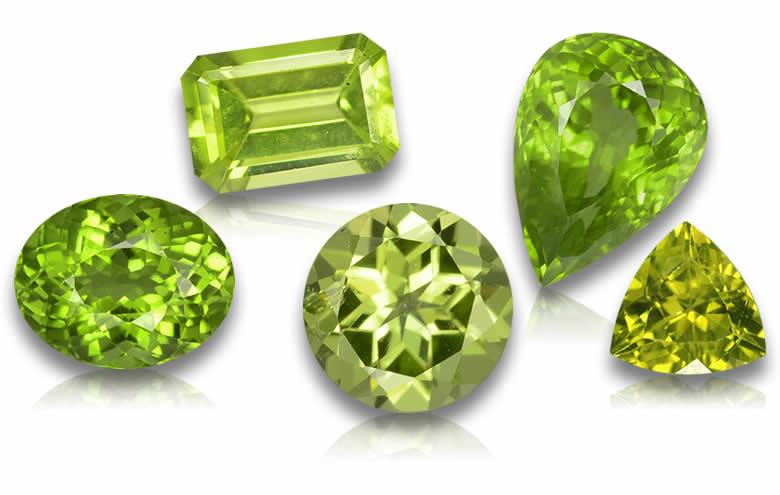Quick info about Topaz Birthstone
- Official birthstone: November
- Colors: Most commonly yellow to golden, but can also be found in a range of colors
- Meaning: Love, affection, and success
- Zodiac signs: Scorpio and Sagittarius
- Mohs hardness: 8
Birthstones hold a significant place in human history, often seen as a reflection of one’s identity and personal connection to the cosmos. These precious gemstones, traditionally associated with each month of the year, have captivated people for centuries due to their beauty and alleged mystical properties.
The tradition of birthstones can be traced back to ancient times when civilizations attributed special meanings to specific gems. In this article, we delve into the world of birthstones, focusing on Topaz as the birthstone for November.
Brief Overview of Birthstones and Their Significance
From January’s garnet to December’s turquoise, birthstones have been chosen based on their beauty and symbolic qualities that resonate with each month. These gemstones are believed to bring good luck, protection from harm, and enhance one’s well-being.
Wearing a birthstone is considered an act of channeling its inherent power into one’s life. The concept of associating gemstones with specific months can be traced back to the breastplate worn by Aaron, the High Priest in biblical times.
The breastplate contained twelve stones representing the twelve tribes of Israel. Over time, various cultures developed their own lists associating different gems with each month.
In modern times, there are several recognized birthstone lists including those from official organizations like the American Gem Society (AGS) and Jewelers of America (JA). Despite some variations among these lists, Topaz remains consistently recognized as November’s birthstone.
Introduction to Topaz as the Birthstone for November
Topaz holds a prominent position among gem enthusiasts due to its remarkable beauty and rich history. As November’s official birthstone according to many traditions worldwide, Topaz embodies unique qualities that resonate with individuals born during this month.
The name “Topaz” originates from the ancient Greek word “Topáziοn,” meaning “to seek.” This etymology reflects the gemstone’s allure and the desire it evokes in those who encounter its captivating hues. Topaz is known for its exceptional clarity, making it a sought-after gemstone for jewelry and decorative purposes.
Adorning oneself with Topaz is believed to bring forth qualities such as love, loyalty, and strength. It is said to bestow clarity of thought upon the wearer, unlocking intellectual potential and stimulating creativity.
Additionally, Topaz has been associated with healing properties, particularly in soothing emotional distress and promoting feelings of calmness. Overall, as we embark on this journey to explore the wonders of Topaz – the enchanting birthstone for November – we will uncover its historical significance, delve into its geological origins and physical properties, explore its various varieties and famous examples throughout history, examine its symbolic meanings and alleged healing properties, discuss tips for caring for topazes, and guide you through purchasing this precious gemstone from reputable sources.
Historical Significance of Topaz
Ancient beliefs and myths surrounding Topaz
In the realm of gemstones, few have captured the imagination and reverence quite like topaz. This alluring gemstone has been steeped in rich historical significance across various cultures throughout centuries.
Ancient civilizations held a deep fascination with topaz, attributing it with powerful symbolism and mystical properties. From the Egyptians to the Greeks, topaz was revered as a stone of great importance.
Egyptian association with the sun god Ra
In ancient Egyptian mythology, topaz was believed to hold a direct connection to the sun god, Ra. The Egyptians regarded Ra as one of their most influential deities, embodying power and divine energy.
Topaz was considered to be a symbol of his life-giving rays that illuminated the world. It was thought that wearing or possessing topaz would bring abundance, protection, and vitality into one’s life.
Greek belief in Topaz’s power to increase strength and intelligence
The Greeks also held an esteemed position for topaz within their culture. They believed that this gemstone possessed remarkable qualities that could enhance both physical strength and mental acuity.
It was believed that wearing or carrying topaz would increase one’s stamina during physical exertion while simultaneously sharpening their intellect. Scholars often adorned themselves with topazes during academic pursuits as they believed it would grant them greater wisdom and intellectual prowess.
Topaz’s historical significance goes beyond its perceived associations with deities or supernatural powers—it served as a symbol of status and prestige throughout ancient civilizations. The rich golden hues of yellow or brown topazes were particularly valued among nobility due to their resemblance to illuminated flames or glowing embers.
Kings and queens adorned themselves with these captivating gems as a signifier of their elevated social standing. Throughout history, from ancient Egypt to Greece, topaz has captivated the imaginations of people across cultures.
Its association with the sun god Ra and its perceived ability to enhance strength and intelligence made it a stone of great reverence. The allure of topaz continues to endure, captivating both collectors and those born under November’s sign as they celebrate their birthstone.
Geological Background of Topaz
Formation process of Topaz in nature
Topaz is a delightful gemstone that forms through intricate geological processes. It primarily occurs in igneous rocks, which are formed from the cooling and solidification of molten materials.
The formation of topaz starts with the presence of fluids rich in silicate minerals within these igneous rocks. These fluids contain elements such as aluminum, silicon, and fluorine, which play a vital role in the creation of topaz.
During the cooling phase, as the molten rock begins to solidify, these fluids escape from the magma chamber and fill cracks and cavities within surrounding rocks. Over time, as these fluids gradually cool, they undergo a process called fractional crystallization.
This means that certain minerals begin to crystallize at different temperatures, causing them to separate from the remaining liquid. Within this process, conditions become ideal for topaz to form.
The combination of high temperatures and pressure triggers the crystallization of dissolved elements into topaz crystals. This happens particularly when there is an abundant supply of fluorine within these fluids.
Role of heat and pressure in its creation
Heat and pressure are essential factors that contribute to the formation and development of topaz crystals. Under high-pressure conditions deep within Earth’s crust or during volcanic activity, minerals dissolve into highly heated liquids or gases known as hydrothermal fluids.
These hydrothermal fluids serve as carriers for various elements necessary for topaz formation. As they migrate through fissures and fractures within rocks, they encounter cooler environments where rapid crystallization occurs due to a decrease in temperature.
During this process, heat acts both as a catalyst for chemical reactions and an energy source that allows atoms to rearrange themselves into a stable crystal lattice structure characteristic of topaz. Additionally, immense pressure aids in facilitating mineral dissolution within these hydrothermal fluids, allowing for the incorporation of a wide range of chemical elements into the growing topaz crystals.
Locations where Topaz is commonly found
Topaz is known to exist in several regions worldwide, each with its unique geological conditions conducive to its formation. Some of the most notable sources include Brazil, Russia, Afghanistan, Nigeria, and Sri Lanka. Brazil is renowned for its rich deposits of topaz.
The state of Minas Gerais is particularly famous for producing significant quantities of high-quality topaz gemstones in various stunning colors. Russian topaz deposits are found mainly in the Ural Mountains and Siberia, with some exceptional blue specimens coming from these regions.
Afghanistan’s rugged mountainous regions house significant topaz deposits. The country’s mines have yielded stunning yellow and golden-colored specimens.
Nigeria is another notable source of topaz, often producing gems with warm hues ranging from pale yellows to deep cognac browns. Sri Lanka is known for its production of pink and blue topazes.
The Ratnapura district in this island nation has been a prolific source of colorful gems for centuries. These locations provide ideal geological conditions where heat and pressure fluctuations have allowed nature to create exquisite topaz crystals over millions of years.

Physical Properties of Topaz
Description of its crystal structure and chemical composition
Topaz is a silicate mineral with the chemical formula Al2SiO4(F,OH)2. It belongs to the orthorhombic crystal system, characterized by three mutually perpendicular axes of unequal length.
The crystal structure of topaz consists of interconnected tetrahedrons and octahedrons, with aluminum (Al) at the center and surrounded by oxygen (O) atoms. The presence of fluorine (F) or hydroxyl (OH) groups within the structure gives rise to variations in the chemical composition.
Range of colors exhibited by different types of Topaz
Topaz exhibits a diverse range of colors, making it a highly prized gemstone. The most common natural colors include yellow, brown, blue, pink, and colorless varieties. Yellow topaz is often associated with warmth and energy, while brown topaz evokes an earthy tone.
Blue topaz has become increasingly popular due to its captivating hue reminiscent of clear skies or serene oceans. Pink topaz is a rare find and is commonly sought after for its delicate and romantic shade.
Natural colors: yellow, brown, blue, pink, etc.
Yellow topazes are typically found in shades ranging from pale lemon to deep golden hues. Some rare specimens may even display a rich imperial yellow coloration known as Imperial Topaz. Brown topazes can vary from lighter shades resembling cognac to deeper tones resembling fine chocolate.
Blue topazes come in various intensities ranging from delicate sky blue to vibrant Swiss Blue or intense London Blue varieties. Pink topazes are highly desirable due to their soft rosy tones that range from blush pink to deeper magenta hues.
Enhanced colors through treatments such as irradiation or heat
To enhance the color of topaz, several treatments are employed within the gemstone industry. Irradiation is commonly used to create blue topaz by exposing colorless or pale yellow stones to radiation.
The process alters the crystal lattice, resulting in a vivid blue hue. Heat treatment is another method used to improve the color and clarity of topazes.
Heat can transform brown or yellowish topazes into attractive shades of pink or red, depending on their chemical composition. It’s important to note that enhanced colors in topaz should always be disclosed transparently at the time of purchase.
By understanding the physical properties of topaz, including its crystal structure and chemical composition, as well as its wide range of natural colors and enhanced varieties through treatments like irradiation and heat, we gain a deeper appreciation for this captivating gemstone. Topaz’s ability to display such a diverse palette makes it an alluring choice for jewelry enthusiasts seeking unique and vibrant pieces that reflect their personality and style preferences.
Varieties and Famous Examples of Topaz
Blue Topaz: Differentiating between Natural Blue Topaz and Enhanced Varieties
Blue topaz is a popular variety of topaz that captivates with its soothing azure hues. However, it’s important to understand the distinction between natural blue topaz and the enhanced varieties found in the market.
Natural blue topaz is relatively rare, occurring in shades ranging from a pale sky blue to a vibrant Swiss Blue. These colors are typically produced by trace elements such as iron or chromium during the crystal’s formation.
On the other hand, enhanced blue topazes are achieved through irradiation and heat treatments. London Blue is one such enhanced variety renowned for its deep, intense hue reminiscent of a stormy evening sky.
Swiss Blue, another enhanced type, exhibits a vivid and vibrant blue color reminiscent of tropical oceans. While these enhancements have made beautiful blue topazes more accessible to consumers on a larger scale, it is crucial to ensure transparency regarding treatments when purchasing this gemstone.
Yellow Topaz: The Significance of Yellow Topazes in Ancient Cultures
Yellow topaz has held significant cultural value throughout history. In ancient civilizations such as Egypt and Rome, yellow topazes were believed to possess divine powers associated with the sun god Ra or Jupiter.
These gems were associated with abundance, prosperity, and protection against evil influences. One remarkable instance of yellow topaz’s historical significance is Imperial topaz.
It earned its name due to its association with Russian tsars during the 18th century who considered it exclusive to their realm. Imperial topazes display rich golden hues with undertones ranging from peach to pinkish-orange, captivating collectors with their regal allure even today.
Pink Topaz: Rarity and Desirability Among Gem Collectors
Pink topazes are among the rarest and most sought-after varieties of this mesmerizing gemstone. Natural pink topaz derives its delicate blush tones from trace impurities of chromium or manganese.
These exquisite gemstones are prized for their exceptional beauty and scarcity, making them highly desirable among collectors. One notable example is the Rosa do Sul, a rare pink topaz found in Minas Gerais, Brazil.
These gems evoke a sense of romance with their soft, rosy hues ranging from pale pastels to deeper blush tones. The limited availability of natural pink topazes contributes to their exclusivity and makes them highly coveted by gem enthusiasts worldwide.
The world of topaz encompasses a splendid array of colors that captivate both casual admirers and seasoned collectors. From the distinction between natural blue topaz and enhanced varieties like London Blue or Swiss Blue to the significance in ancient cultures awarded to yellow topazes such as Imperial topaz, each variety holds its unique allure.
Additionally, the rarity and desirability of pink topazes like Rosa do Sul demonstrate their timeless appeal among gem aficionados. Exploring these varieties only deepens our appreciation for the captivating beauty that November’s birthstone – Topaz – brings to our world.
Topaz Symbolism and Healing Properties
The Profound Symbolic Meanings of Topaz throughout History
Throughout the ages, topaz has captivated the imagination of cultures worldwide, attributing it with various symbolic meanings. One of the most prevalent symbolic associations with topaz is love.
In ancient Egyptian mythology, topaz was linked to the sun god Ra, who represented life-giving energy and passion. The radiant golden hue of yellow topaz was believed to embody Ra’s fiery essence, making it a symbol of divine love.
Moreover, in medieval Europe, topaz became associated with protection from evil forces. It was believed that wearing or carrying a topaz amulet could ward off dark spirits and bring good luck.
This belief stemmed from an old tale of a Roman soldier who wore a topaz pendant as a talisman for protection during battles. He survived unscathed due to the perceived magical powers vested within this precious gemstone.
The Alleged Healing Properties Attributed to Wearing or Using Topazes
Beyond its symbolic significance, topaz has long been cherished for its alleged healing properties that extend beyond just physical ailments. One notable attribute attributed to wearing or using topazes is its ability to calm emotions and soothe turbulent minds. It is believed that by placing a soothing blue or soothing pink topaz on one’s body, emotional distress can be alleviated and replaced with feelings of tranquility and serenity.
In addition to its calming effects on emotions, yellow topazes have been reputed for their supposed assistance in improving digestion. Ancient cultures believed that wearing or ingesting powdered yellow topazes could stimulate metabolic processes and aid in digestion-related issues such as indigestion or stomach discomfort.
It is important to note that these purported healing properties are based on ancient beliefs and folklore rather than scientific evidence. While topaz has a rich history of being associated with positive energies, it is essential to seek professional medical advice for any health-related concerns.
Caring for and Buying Topazes
Cleaning and Maintenance:
To keep your topaz jewelry looking its best, it is important to provide proper care and maintenance. Topaz has a hardness of 8 on the Mohs scale, making it fairly durable.
However, it is still susceptible to scratches and chips if not handled with care. Avoid wearing your topaz jewelry while engaging in activities that may subject it to harsh impacts or abrasions.
To clean topazes, use warm soapy water and a soft brush to gently remove any dirt or debris. Avoid using ultrasonic cleaners or steamers, as excessive heat can cause damage.
Storage:
To prevent scratches or damage when storing your topaz jewelry, it is recommended to keep them separate from other gemstones or metals that may cause friction. Store each piece in a soft cloth pouch or individual compartment in a jewelry box. Additionally, avoid exposing your topazes to direct sunlight for prolonged periods as this can cause fading of certain varieties.
Buying Tips:
When purchasing a topaz gemstone or piece of jewelry, there are several factors to consider. First and foremost, ensure that you are buying from a reputable source with clear information about the stone’s origin and any treatments it may have undergone.
Topazes come in various colors including blue, yellow, pink, and more. Consider the color that resonates with you most or matches the recipient’s preferences for an ideal choice.
Furthermore, evaluate the clarity of the stone by examining its transparency and absence of visible inclusions or fractures. The cut of the gemstone also plays an essential role in its overall beauty and brilliance; select cuts that enhance the natural characteristics of the stone while maximizing its sparkle.
Determine whether you prefer natural topazes or if you are open to enhanced varieties such as irradiated yellow or blue topazes. Both options have their merits, but being aware of the treatments applied will ensure you make an informed decision.
Conclusion
Topaz is a captivating gemstone with a rich history and remarkable beauty. From its ancient associations with power and intelligence to its diverse range of colors, topaz continues to captivate jewelry enthusiasts worldwide.
By providing proper care and maintenance, your topaz jewelry can retain its splendor for years to come. When purchasing topazes, remember to buy from reputable sources and consider factors such as color preference, clarity, cut, and treatments applied.
Whether you choose a natural or enhanced variety, the allure of topaz will not disappoint. Embrace the enchantment of this stunning birthstone and let it adorn your life with elegance and brilliance.





